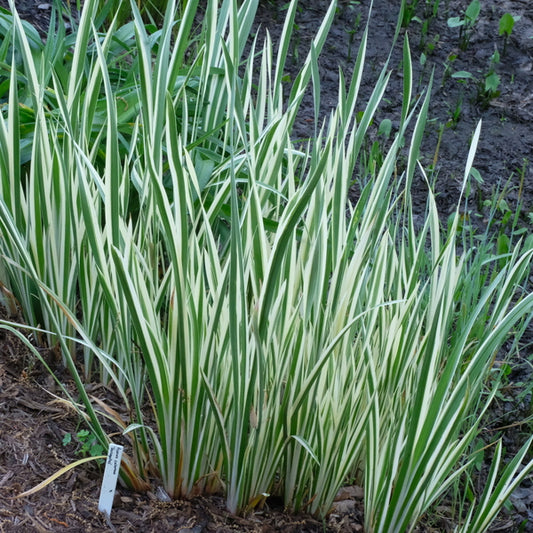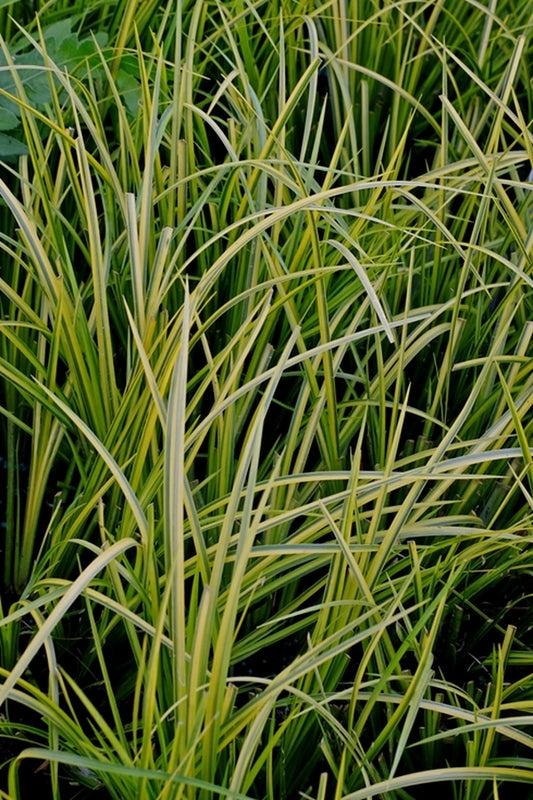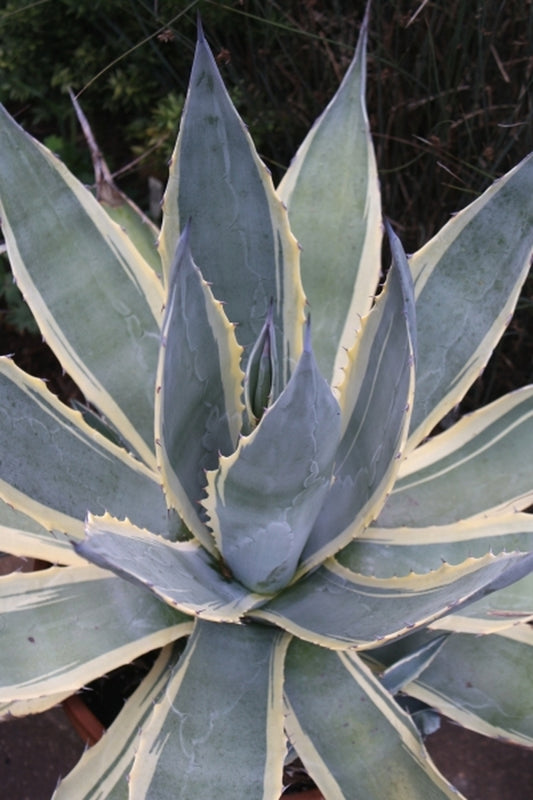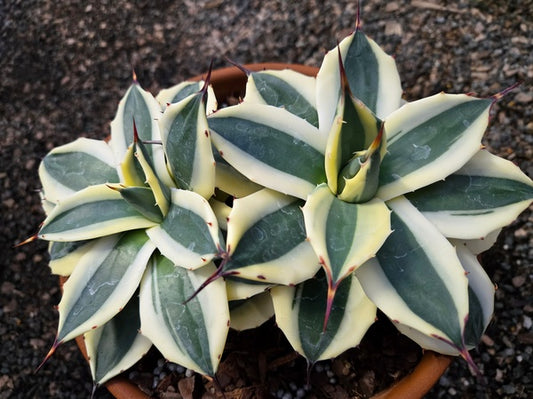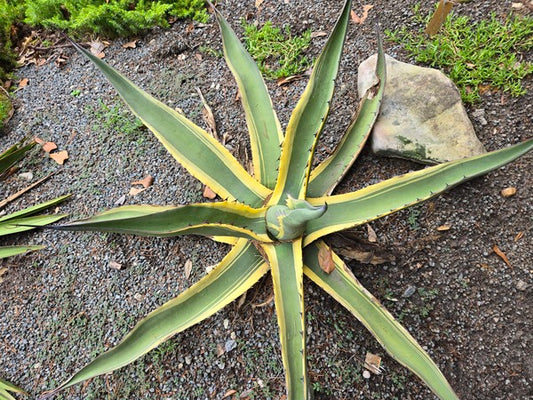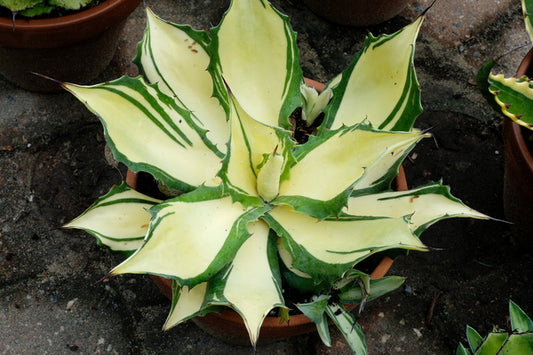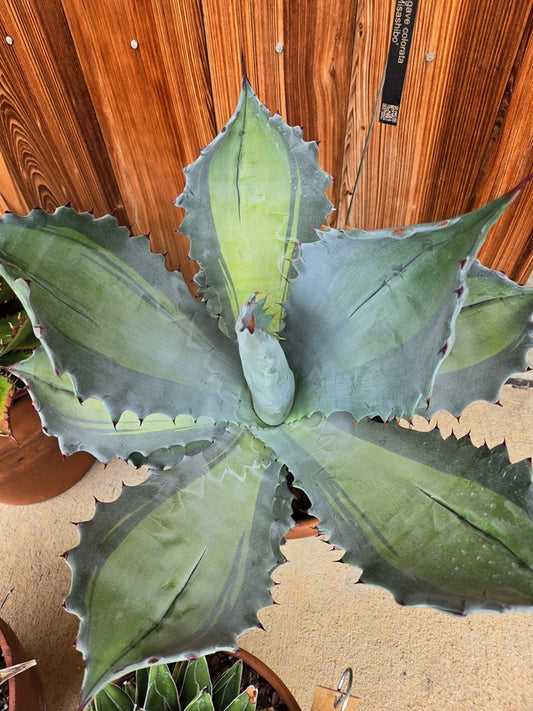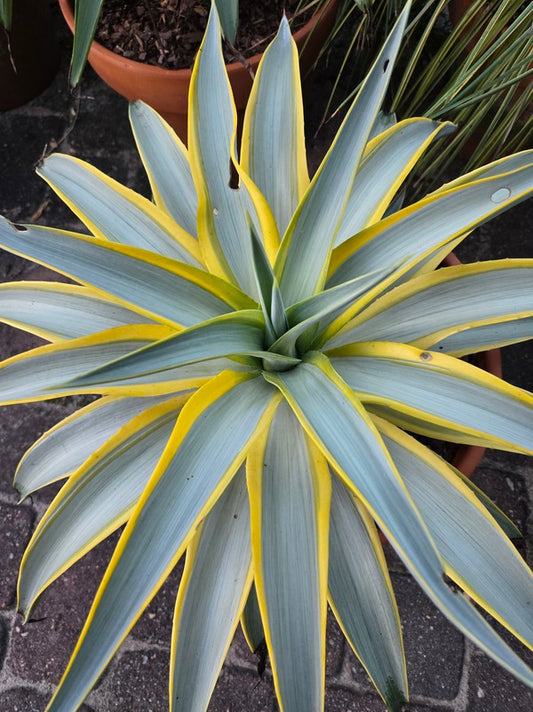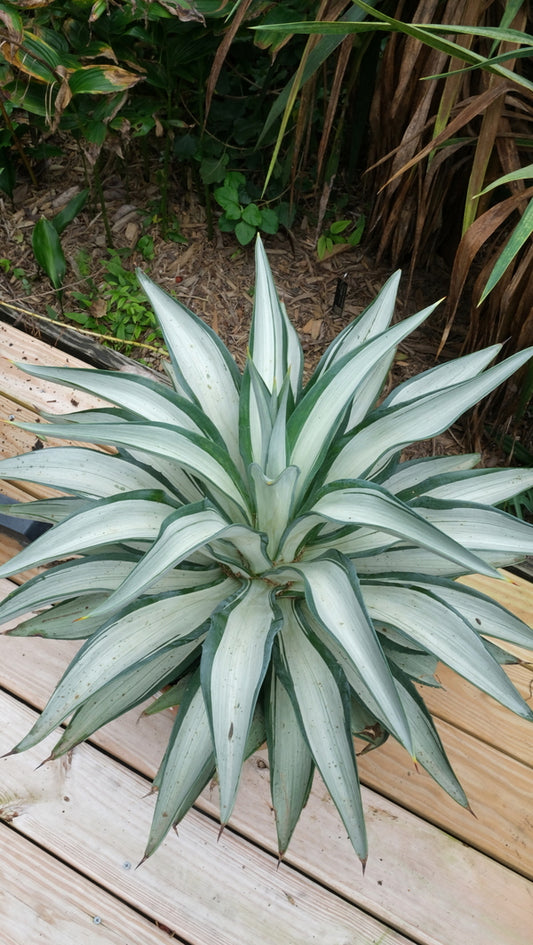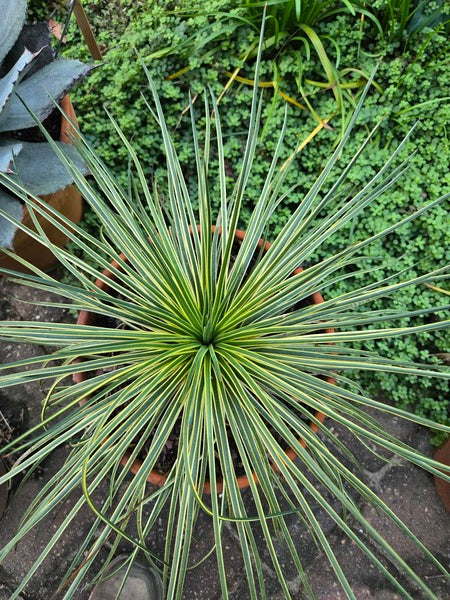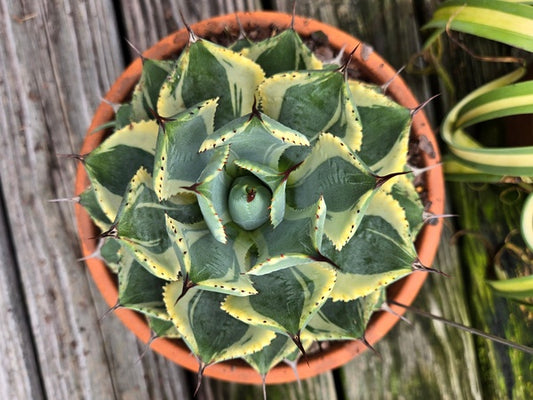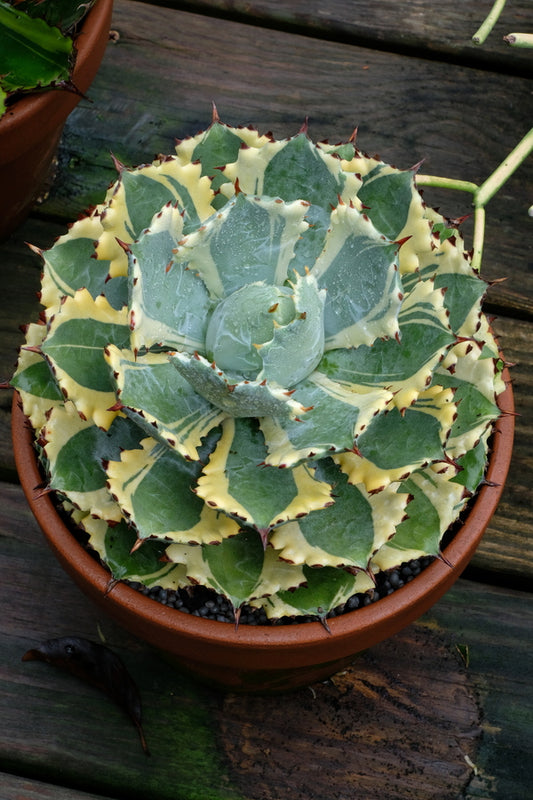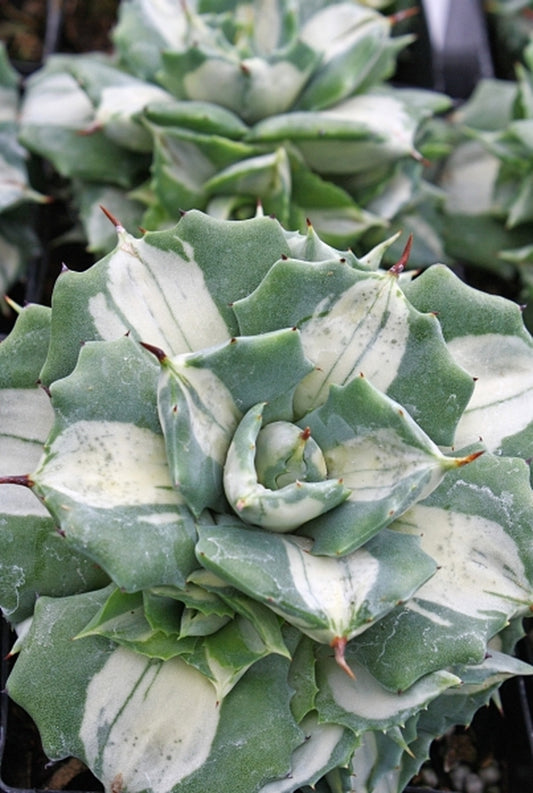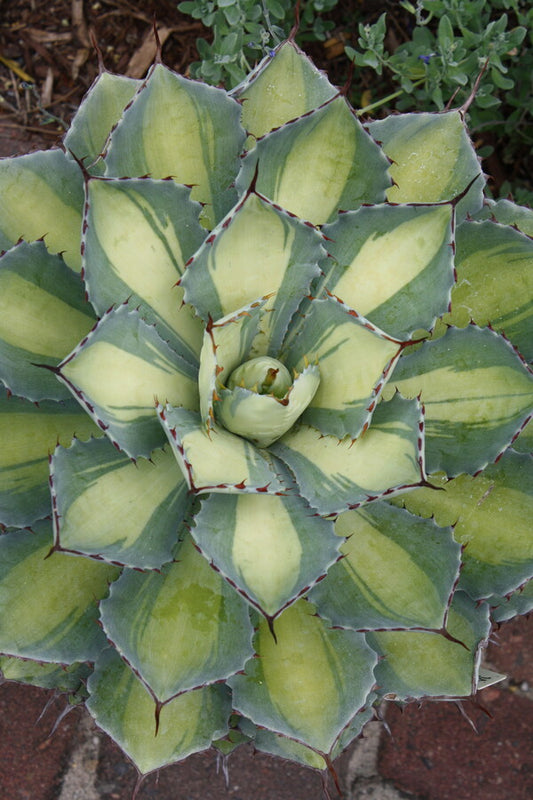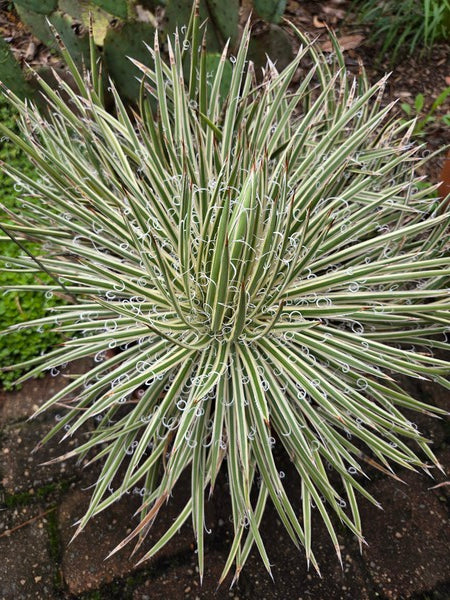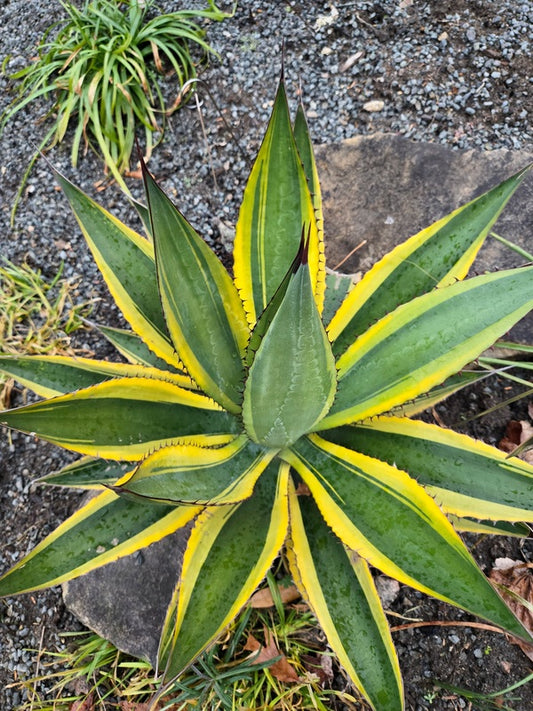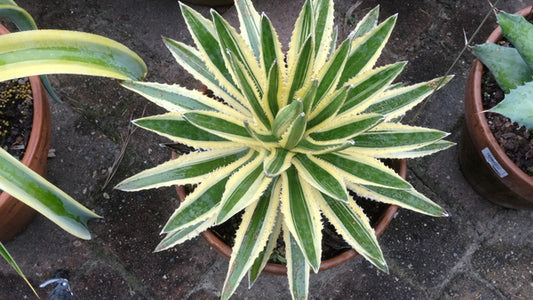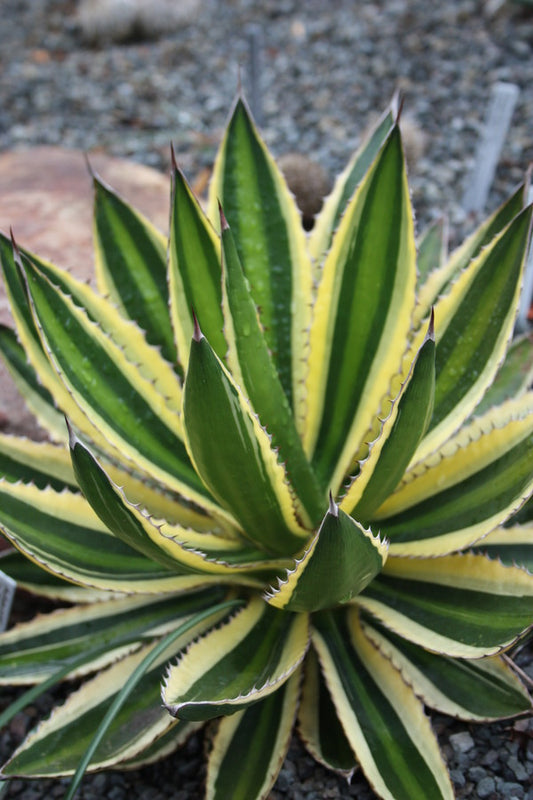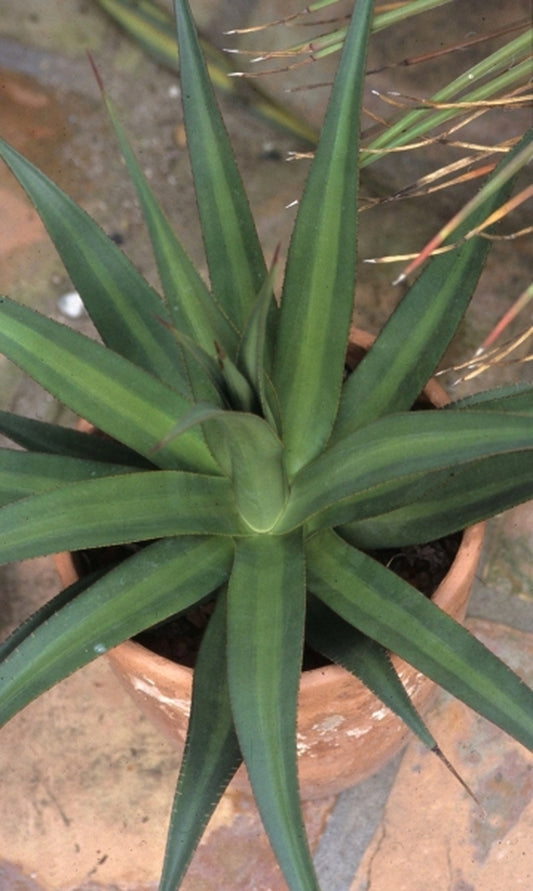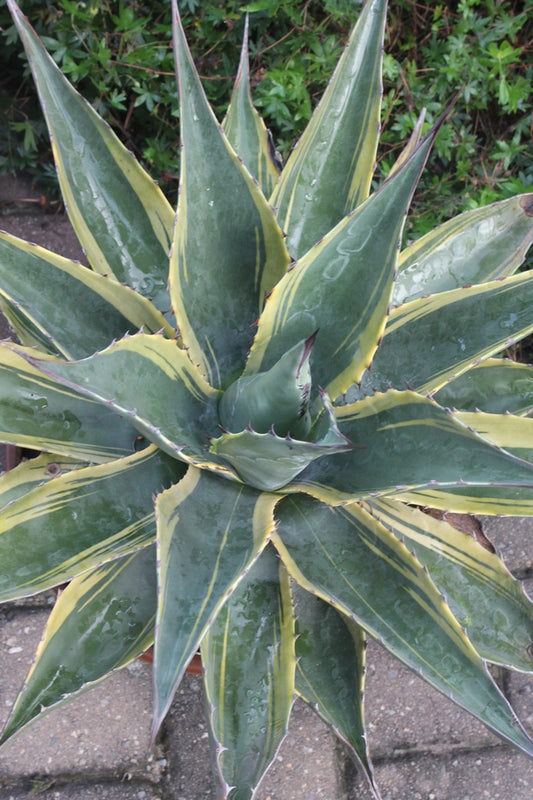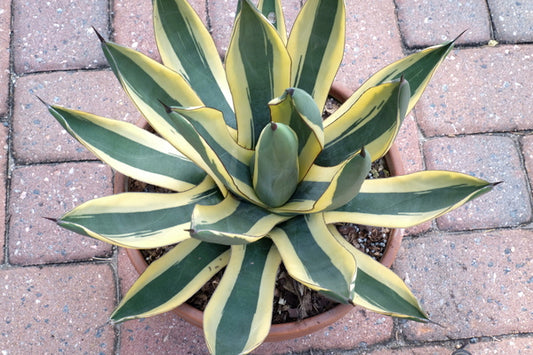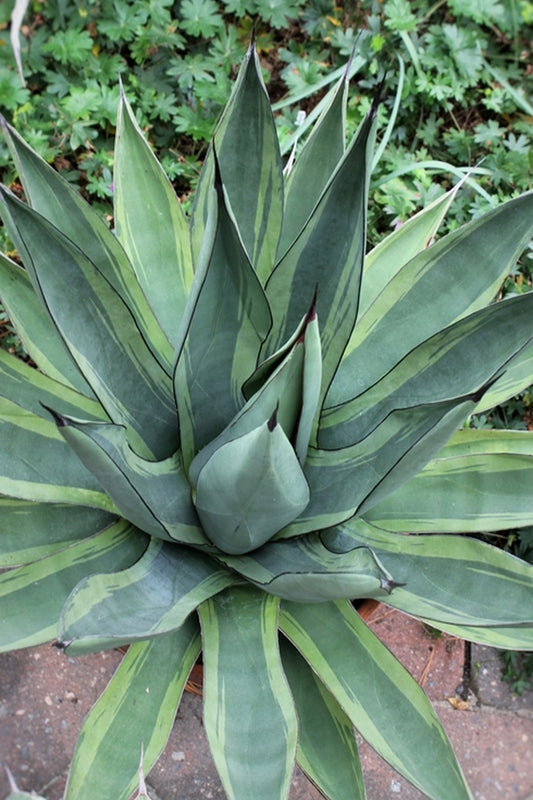By definition a variegated plant is one whose tissues vary in color. In the garden, variegated plants can lighten up a normally dark landscape. In landscape design, variegated plants are often used as the center of attention or as a focal point in the landscape.
-
Acorus calamus 'Variegatus'
Item #: 767
Zones: 4a to 9b
Dormancy: Winter
Height: 36" tall
Culture: Sun to Part Sun
Origin: Europe
Pot Size: 3.5" pot (24 fl. oz/0.7 L)
Regular price $24.00Regular priceUnit price per -
Acorus gramineus 'Ogon'
Item #: 369
Zones: 5a to 9b
Dormancy: Evergreen
Height: 12" tall
Culture: Part Sun to Light Shade
Origin: China, Japan
Pot Size: 3.5" pot (24 fl. oz/0.7 L)
Regular price $22.00Regular priceUnit price per -
Agave americana 'Marshmallow Cream'
Item #: 7869
Zones: 9a to 10b, guessing
Dormancy: Evergreen
Height: 60" tall
Culture: Sun
Origin: Mexico
Pot Size: 3.5" pot (24 fl. oz/0.7 L)
Regular price $35.00Regular priceUnit price per -
Agave applanata 'Butter Cream'
Item #: 13072
Zones: 9a to 10b
Dormancy: Evergreen
Height: 3" tall
Culture: Sun
Origin: Mexico
Pot Size: 3.5" pot (24 fl. oz/0.7 L)
Regular price $32.00Regular priceUnit price per -
Agave applanata 'Cream Spike'
Item #: 7241
Zones: 9a to 10b
Dormancy: Evergreen
Height: 10" tall
Culture: Sun
Origin: Mexico
Pot Size: 3.5" pot (24 fl. oz/0.7 L)
Regular price $30.00Regular priceUnit price per -
Agave asperrima ssp. maderensis 'Grand Duke'
Item #: 12313
Zones: 8a to 10b, possibly colder
Dormancy: Evergreen
Height: 18" tall
Culture: Sun to Part Sun
Origin: Mexico
Pot Size: 3.5" pot (24 fl. oz/0.7 L)
Regular price $30.00Regular priceUnit price per -
Agave 'Bareback Rider'
Item #: 12082
Zones: 9b to Tropical
Dormancy: Evergreen
Height: 12" tall
Culture: Sun to Part Sun
Origin: Hybrid
Pot Size: 3.5" pot (24 fl. oz/0.7 L)
Regular price $39.00Regular priceUnit price per -
Agave colorata 'Misashibo'
Item #: 9921
Zones: 9a to 11
Dormancy: Evergreen
Height: 12" tall
Culture: Sun to Part Sun
Origin: Mexico
Pot Size: 3.5" pot (24 fl. oz/0.7 L)
Regular price $35.00Regular priceUnit price per -
Agave 'Craziness'
Item #: 9521
Zones: 8b to 10b
Dormancy: Evergreen
Height: 30" tall
Culture: Sun
Origin: Mexico
Pot Size: 3.5" pot (24 fl. oz/0.7 L)
Regular price $100.00Regular priceUnit price per -
Agave desmettiana 'Galactic Traveler'
Item #: 16993
Zones: Tropical
Dormancy: Evergreen
Height: 36" tall
Culture: Part Sun
Origin: Mexico
Pot Size: 3.5" pot (24 fl. oz/0.7 L)
Regular price $39.00Regular priceUnit price per -
Agave desmettiana 'Quicksilver'
Item #: 17242
Zones: Tropical
Dormancy: Evergreen
Height: 36" tall
Culture: Part Sun
Origin: Mexico
Pot Size: 3.5" pot (24 fl. oz/0.7 L)
Regular price $39.00Regular priceUnit price per -
Agave geminiflora 'Leaping Lizards'
Item #: 13528
Zones: 9b to 11, at least
Dormancy: Evergreen
Height: 20" tall
Culture: Part Sun to Light Shade
Origin: Mexico
Pot Size: 3.5" pot (24 fl. oz/0.7 L)
Regular price $39.00Regular priceUnit price per -
Agave 'Good Morning'
Item #: 17999
Zones: 9a to 10b, guessing
Dormancy: Evergreen
Height: 12" tall
Culture: Sun to Part Sun
Origin: Hybrid
Pot Size: 3.5" pot (24 fl. oz/0.7 L)
Regular price $29.00Regular priceUnit price per -
Agave isthmensis 'Kabuto Gani'
Item #: 13719
Zones: Tropical
Dormancy: Evergreen
Height: 12" tall
Culture: Sun to Part Sun
Origin: Mexico
Pot Size: 3.5" pot (24 fl. oz/0.7 L)
Regular price $30.00Regular priceUnit price per -
Agave isthmensis 'Ohi Raijin Shiro Nakafu'
Item #: 8524
Zones: Tropical
Dormancy: Evergreen
Height: 4" tall
Culture: Sun to Part Sun
Origin: Mexico
Pot Size: 3.5" pot (24 fl. oz/0.7 L)
Regular price $32.00Regular priceUnit price per -
Agave 'Kissho Kan Nishiki'
Item #: 7617
Zones: Tropical
Dormancy: Evergreen
Height: 15" tall
Culture: Sun
Origin: Hybrid
Pot Size: 3.5" pot (24 fl. oz/0.7 L)
Regular price $32.00Regular priceUnit price per -
Agave x leopoldii 'Spike'
Item #: 13746
Zones: 8b to 10b
Dormancy:
Height: 6" tall
Culture: Sun
Origin: Hybrid, Mexico
Pot Size: 3.5" pot (24 fl. oz/0.7 L)
Regular price $34.00Regular priceUnit price per -
Agave x loferox 'Sunshine Superman'
Item #: 14370
Zones: 7b to 10b, at least
Dormancy: Evergreen
Height: 24" tall
Culture: Sun
Origin: Hybrid
Pot Size: 3.5" pot (24 fl. oz/0.7 L)
Regular price $50.00Regular priceUnit price per -
Agave lophantha 'Candida'
Item #: 13345
Zones: 9b to 10b, guessing
Dormancy: Evergreen
Height: 12" tall
Culture: Sun to Part Sun
Origin: Mexico
Pot Size: 3.5" pot (24 fl. oz/0.7 L)
Regular price $50.00Regular priceUnit price per -
Agave lophantha 'Quadricolor'
Item #: 7124
Zones: 8a to 10b, guessing
Dormancy: Evergreen
Height: 18" tall
Culture: Sun to Part Sun
Origin: Mexico
Pot Size: 3.5" pot (24 fl. oz/0.7 L)
Regular price $30.00Regular priceUnit price per -
Agave 'Mateo'
Item #: 8929
Zones: 7b to 10b, at least
Dormancy: Evergreen
Height: 18" tall
Culture: Sun to Part Sun
Origin: Hybrid
Pot Size: 3.5" pot (24 fl. oz/0.7 L)
Regular price $31.00Regular priceUnit price per -
Agave montana 'Tiffany'
Item #: 9871
Zones: 9a to 10b, possibly colder
Dormancy: Evergreen
Height: 20" tall
Culture: Sun to Part Sun
Origin: Mexico
Pot Size: 3.5" pot (24 fl. oz/0.7 L)
Regular price $50.00Regular priceUnit price per -
Agave x nigra 'Great White Shark' PP 32,484
Item #: 10671
Zones: 9b to 11
Dormancy: Evergreen
Height: 18" tall
Culture: Sun to Part Sun
Origin: Hybrid
Pot Size: 3.5" pot (24 fl. oz/0.7 L)
Regular price $60.00Regular priceUnit price per -
Agave x nigra 'Shark Bite'
Item #: 9575
Zones: 8a to 11
Dormancy: Evergreen
Height: 18" tall
Culture: Sun to Part Sun
Origin: Hybrid
Pot Size: 3.5" pot (24 fl. oz/0.7 L)
Regular price $32.00Regular priceUnit price per
More Information About Variegated Foliage Plants
What is the definition of a variegated plant?
Variegation is defined as the phenomenon where parts of a plant leaf, stem or fruit have zones whose color varies from the surrounding tissue or from normal tissue. Variegation can be part of a plant's adaptation to its environment where the color patterns attract pollinators or seed dispersers to the plant. For example, the purple chevrons seen on Curcuma or the purple spots on the stems of Amorphophallus. Or a plant may be variegated due to a genetic flaw in a particular tissue that prevents the production of the normal green pigment chlorophyll...like Hostas and Agaves with yellow leaf edges. Or variegation can be caused by viruses or other disease organisms.
(Article excerpt from Leaves that Light Up the Garden):
Variegated plants are most appreciated by serious plant collectors, probably because of their uniqueness. If everyone has a green form of plant , then the plant collector naturally wants to have the variegated form, often simply to be different.
Some gardeners like the patterning in the leaf...usually the arts and croissant crowd. Designers often like the ability of variegated plants to lighten up a normally dark landscape. In a landscape design, variegated plants are often used as the center of attention or as a focal point in the landscape.
Inquiring minds want to know what qualifies as a variegation. Variegation in plants is defined as the normal green portion of the plant leaf being replaced by white, cream, yellow, or occasionally other colors, which may be in the form of blotches or stripes. The variegations can occur on the edge of the leaves (marginate variegation), or in the center of the leaf (medio variegation.) Variegated plants which have neat regular leaf margins of white or gold and tend to be the most accepted by gardeners.
Less accepted by gardeners are variegated plants whose foliage is streaked with uneven patterning. These plants are often highly prized by plant collectors and completely shunned by most other gardeners. I must admit that most of these plants have foliage that sometimes resembles a classic case of micronutrient deficiency. The most common example is that of the variegated canna lily (Canna Nirvana...syn Minerva). The strangest of variegations of course are the horizontal banding, seen in some of the ornamental grasses.
Now I hope you are ready to give a variegated plant an even break. Don't try to collect everything variegated, but instead use the variegation as a design tool to highlight not only the variegated plant, but the rest of the garden also. Careful placement, integrating both texture and color can make variegated plants an essential element of the garden.


